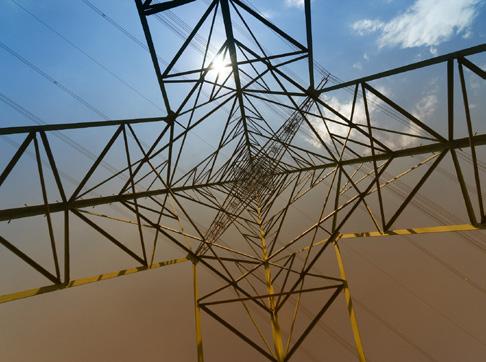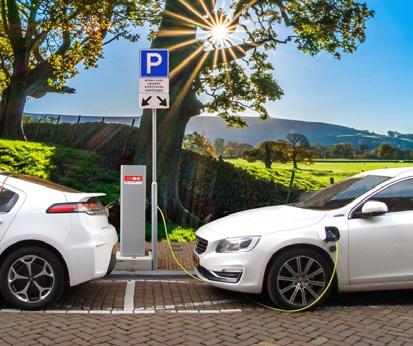
10 minute read
Smart Grids
How can low carbon microgrids help manufacturers?
To reduce their reliance on fossil fuels and minimise their carbon footprint, an increasing number of companies are implementing low-carbon microgrids. Just like traditional microgrids, low-carbon ones can help firms meet their energy demands without depending solely on the national grid. Unlike traditional solutions, however, these eco-friendly microgrids are almost zero-emission. Neil Ballinger, head of EMEA at EU Automation, explains the benefits for manufacturers.
Advertisement
Amicrogrid is a localised group of energy resources and loads that can operate independently and when connected to the wide area grid. The ability to work in island mode is what differentiates a microgrid from other forms of on-site energy generation. This also makes microgrids a popular option among manufacturers who wish to secure a steady supply of electricity without having to rely solely on their country’s national grid.
A microgrid is formed by connection to a point of common coupling (PCC), a source of energy supply and a charge/discharge storage system, in the form of batteries, for example. Traditional microgrids rely on fossil fuels as a source of energy supply. However, low-carbon microgrids use renewable sources, such as solar panels or wind turbines, to generate a significant part or even all of their energy supply.
Improved reliability There are three scenarios where microgrids have traditionally been used and where low-carbon solutions are now on the rise. These include offgrid areas, areas with unsatisfactory or intermittent grids, and areas with reliable grids but high security needs.
Off-grid areas are still common in some regions of Africa, some small islands, and sparsely populated territories such as central Australia. Despite their lower level of industrialisation, these areas are important in sectors such as the extractive industry, as they are rich in mineral resources. In this scenario, low-carbon microgrids offer new opportunities to satisfy the sector’s energy needs while reducing the considerable environmental impact of mineral extraction.
Areas with insufficient or intermittent grids are still prevalent in many developing regions, such as Latin America and the Indian subcontinent. Normally, manufacturers in these regions use diesel generators as a back-up power solution. However, the price of diesel is subject to market fluctuations, so low-carbon microgrids represent a cheaper and more sustainable option.
In industrialised countries, low-carbon microgrids are used in areas where the electricity supply is steady and reliable, but where the need for security is paramount, such as hospitals, airports, data centres and military bases.
Microgrids can be completely off-grid and operate in constant island mode, being the sole power source for their customers. This is the case, for example, on the Isle of Eigg in Scotland. Prior to the installation of microgrids, the island’s few residents depended on unreliable, expensive and carbon-intensive diesel generators. But in 2008, the island became the world’s first off-grid community powered solely by wind, water and solar. Completed off-grid microgrids have been installed in several communities that, for economic or geographical reasons, didn’t have access to a national grid, such as rural villages in the Manipur state of India or the Native American reservation of Blue Lake Rancheria, in California.
Though many similar projects are taking off, most microgrids today are still connected to the main grid, which represents an additional source of power and provides more flexibility. This is the case of most community microgrids, which provide clean energy to towns that do have access to the grid, but are striving to minimise their carbon footprint while reducing energy bills.
More savings, less carbon Recently, an increasing number of plants with reliable electricity supply have turned to low-carbon microgrids to cut energy bills and reduce their environmental impact.
The main benefit of implementing a solar or wind-based microgrid is economical, since the price of both renewable energies and modern storage solutions is dropping. According to a recent report by the World Business Council for Sustainable Development (WBCSD), the global cost of solar panels fell by more than 60% between 2009 and 2015, while lithium-ion battery costs decreased by more than 50% from 2013 to 2016.
The cost of solar is expected to fall further as adoption rates rise. Moreover, firms can sign a Power Purchase Agreement (PPA) with an external provider of renewable energy solutions, giving them access to a low energy price over a long-term period. Strategies like this can also help manufacturers shield against the volatility of crude oil prices.
Low-carbon microgrids are also an efficient way of reducing a firm’s carbon footprint and therefore its environmental taxes. In areas with carbon offsetting targets, such as the EU Emissions Trading System or the UK Carbon Price Floor, switching to a low-carbon microgrid can drastically cut a plant’s compliance costs. Moreover, reducing emissions can improve a firm’s Corporate Social Responsibility (CSR) rating and enhance its brand image.
The challenges Though microgrids have been installed for decades, there is still no clear legal framework for them, with many states not even having a legal definition of a microgrid. This means, for example, that while financial incentives are usually available for businesses willing to invest in renewables, in some cases it is unclear whether or not these incentives apply to the construction of low-carbon microgrids.
The lack of a clear legal framework also means that business owners might face the risk that new regulations will impose restrictions or costs that they didn’t anticipate while planning or constructing their low-carbon microgrid.
Despite the falling prices of renewable energy sources and their storage solutions, financial hurdles can also contribute to slow down the deployment of microgrids. Microgrids tend to integrate multiple energy sources and are often implemented in geographical areas with unique characteristics or in high-risk applications. As a consequence, investors tend to see them as a challenging project. Public-private partnerships and mixed ownership agreements can help overcome financial barriers, encouraging investment in renewables-powered microgrids.
Despite the challenges to their implementation, low-carbon microgrids represent a smart solution to achieve energy independence, cut energy bills and reduce the impact of the manufacturing sector on fragile ecosystems.
10 steps to going green

Ten simple steps that up your green credentials and save you money? Look no further, Michael Rossman, co-founder at EnergyBillKill.com, is here to tell us how.
he exhausting topic of climate change has been plugged so T much that people and businesses are growing tired of it. However, even the most sceptical among us can agree that being green is important and a no-brainer if it takes very little effort at all.
Being green isn’t just about the environment – it’s also about cutting energy costs, being sustainable and enhancing your brand image. If you are an electrical company that wants to be green, there are ways to go about it while saving money in the process.
1. Carry out an energy assessment/audit An energy audit will assess when, where and how your business uses energy so you can understand your energy use and identify energy-saving opportunities.
An audit will survey your business’ equipment, appliances, energy use, operating patterns and energy supplier to determine any areas of improvement.
It isn’t a disruptive process and it will go a long way to helping you save money and be greener. You can conduct your own energy audit (Gazprom has a good how-to guide) or there are companies that offer them.
2. Create a waste management plan A waste management plan will reduce the amount of waste you produce and ensure that what can be recycled gets recycled. At a basic level, a waste management plan should: • Determine who is responsible for waste. • Establish areas in your business that produce waste. • Set targets for minimising waste. • Put in place measures for waste recycling.
It is estimated between 4.8 and 12.7 million tonnes of plastic enter the ocean each year, as well as several million tonnes of glass and scrap metal. If we all start recycling more, we can make a profound difference to this number.
3. Change to LED light bulbs If your premises use incandescent light bulbs, switching to LED light bulbs will slash your energy consumption per bulb by at least 75%.
If your premises use CFL bulbs (which are more efficient than incandescent bulbs, but not as efficient as LED bulbs), you will slash your energy consumption per bulb by 35%.
LED light bulbs are rated to last around 50,000 hours and they are the most efficient bulbs on the market. They are also available in all sizes.
4. Turn appliances off standby Appliances and electrical tools like drills on standby consume around five to 9kWh of electricity each year. If you multiply that number by the number of appliances and tools you own that are left on standby, the wasted electricity soon adds up.
It’s better for the environment and your wallet to turn appliances and tools off at the plug, even if it adds a little inconvenience to your day.
5. Install low flow aerators on taps Low flow aerators reduce the flow of water from the faucet of a tap without reducing pressure. You can install them in around 30 seconds, and they save around 50% of the water you would normally use at the sink.
Water bills are never extortionately high, however the energy used by water treatment facilities is enormous. By using less water, less water needs to be treated, helping to reduce your impact on the environment.
6. Use a dehumidifier Dehumidifiers are great for garages, workshops and basements that are prone to high humidity. They are also useful indoors for air purification.
A dehumidifier reduces humidity by collecting water from the air. You can reuse this water in your business or on-site.
7. Insulate The leading cause of poor energy efficiency in buildings is poor insulation, but how do you know if this is a problem in your premises?
The easiest way to find out is by having an Energy Performance Certificate conducted. EPCs are available from a commercial energy assessor.
If your building is exempt from requiring an EPC by law, then an EPC will be a voluntary endeavour. We recommend going for it if your business struggles to stay warm and heated when it’s cold outside. 8. Consider Demand Side Response Demand Side Response (DSR) is an intervention you can make to reduce your impact and strain on the National Grid during peak times.
It requires you to turn up, turn down or shift your energy use in response to demand on energy infrastructure. It’s about intelligent energy use and timing your operation to reduce strain and potential electricity supply problems.
9. Supplement your energy supply with self-generated electricity If you can supplement your energy supply with electricity that’s self-generated, you will lower your energy bills and reduce your dependency on the grid.
A large enough solar panel installation on the roof of your property could power 20 to 30% of your premises, such as lighting and small appliances.
Or you might prefer a wind turbine? One turbine is classed as permitted development in non-conservation areas, so long as it stands no taller than 11.1 metres with a swept area no greater than 3.8m. This size of wind turbine would produce around 8 MW a year.
10. Switch to green energy It might surprise you to know that green energy can be cheaper than traditional energy, so long as you compare the market at the right time.
With electricity, you can switch to 100% renewable electricity that is either directly sourced from green and renewable sources or purchased from the National Grid and backed by Renewable Energy Guarantees of Origin (REGOs).
With gas, there is no such thing as 100% renewable gas, however, some suppliers do a carbon offset to offer carbon-neutral gas. A carbon offset measures the amount of gas used and then invests in renewable projects around the world.
As a side note, you can also do your own carbon offsetting by measuring your carbon footprint and investing in renewable projects around the world.
You will be able to switch to green energy when your existing contract runs down. It’s a good idea to compare quotes early to get an idea about prices. Your existing supplier may already offer green energy, but it is unlikely the price they quote you on renewal will be the best you can get.
Energy suppliers are known for offering low introductory prices (for new customers) and high renewal prices (for existing customers). It’s a lot like car insurance in this sense – a merry-go-round that saps trust in energy prices.
Get your quotes in early and you should do well. Green energy should cost you no more than normal energy and it will slash your carbon footprint.








